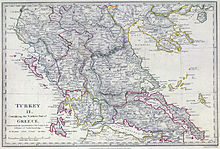Sanjak of Inebahti
| Sanjak of Inebahti Ottoman Turkish: Liva-i Inebahti | |||||||||||
|---|---|---|---|---|---|---|---|---|---|---|---|
| Sanjak of the Ottoman Empire | |||||||||||
| 1499–1821/1829 | |||||||||||
 Central Greece in the early 19th century, showing the sanjak of Inebahti ("Lepanto") in the lower image | |||||||||||
| Capital | Naupaktos (Inebahti/Aynabahti, Lepanto) | ||||||||||
| History | |||||||||||
• Established | 1499 | ||||||||||
| 1821/1829 | |||||||||||
| |||||||||||
| Today part of | |||||||||||
The Sanjak of Inebahti or Aynabahti (Ottoman Turkish: Sancak-i/Liva-i İnebahtı/Aynabahtı; Template:Lang-el) was a second-level Ottoman province (sanjak or liva) encompassing the central parts of Continental Greece. Its name derives from its capital, Inebahti/Aynabahti, the Turkish name for Naupaktos, better known in English with its Italian name, Lepanto.[1]
History
The province was formed in 1499, when the Ottomans conquered Lepanto, which had been a possession of the Republic of Venice since 1407.[1] Much of the territory allocated to the new province, however, had already been under Ottoman control, under the Sanjak of Tirhala.
On 7 October 1571, the famous Battle of Lepanto between the fleets of the Ottoman Empire and the Holy League was fought off the coast of the town of Lepanto.[1] The Venetians retook the town in 1687, during the Morean War, but surrendered it to Turkish control in 1699, after the Treaty of Karlowitz.[1] Although most of the province rose in revolt upon the outbreak of the Greek War of Independence in 1821, the capital Lepanto remained in Ottoman hands until 12 March 1829, when it came under Greek control.[1]
Administrative division
Originally, the sanjak formed part of the Rumeli Eyalet, but after 1533 it was subordinated to the new Eyalet of the Archipelago.[2]
According to the 17th-century geographer Hajji Khalifa, the province encompassed six kazas ("districts"): Inebahti itself, Karavari (Kravara), Abukor (Apokouros), Olendirek/Olunduruk (Lidoriki), Gölhissar and Kerbenesh (Karpenisi).[3][4]
Early 19th-century sources report that the sanjak at the time formed part of the Morea Eyalet, and comprised again six kazas: Inebahti, Abukor, Olendirek/Olunduruk, Gölhissar, Kerbenesh and Patracik (Ypati).[5]
References
- ^ a b c d e Babinger, Franz (1960). "Aynabakhti̊". In Gibb, H. A. R.; Kramers, J. H.; Lévi-Provençal, E.; Schacht, J.; Lewis, B. & Pellat, Ch. (eds.). The Encyclopaedia of Islam, Second Edition. Volume I: A–B. Leiden: E. J. Brill. p. 790. OCLC 495469456.
- ^ Birken, Andreas (1976). Die Provinzen des Osmanischen Reiches. Beihefte zum Tübinger Atlas des Vorderen Orients (in German). Vol. 13. Reichert. pp. 53, 103. ISBN 9783920153568.
- ^ de Vaudoncourt, Guillaume (1816). Memoirs on the Ionian Islands, Considered in a Commercial, Political, and Military Point of View. London: Baldwin, Cradock and Joy. p. 161.
- ^ Rumeli und Bosna, geographisch beschrieben, von Mustafa ben Abdalla Hadschi Chalfa. Aus dem Türkischen übersetzt von J. v. Hammer (in German). Vienna: Verlag des Kunst- und Industrie-Comptors. 1812. pp. 125–127.
- ^ "Reisen ins Osmanische Reich". Jahrbücher der Literatur (in German). 49–50. Vienna: C. Gerold: 22. 1830.
- Use dmy dates from April 2013
- States and territories established in 1499
- Sanjaks of the Ottoman Empire in Europe
- Ottoman Greece
- States and territories disestablished in the 1820s
- Nafpaktos
- History of Aetolia-Acarnania
- History of Phocis
- 1499 establishments in the Ottoman Empire
- 1829 disestablishments in the Ottoman Empire
